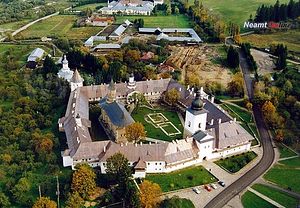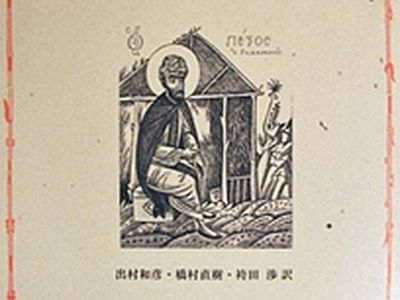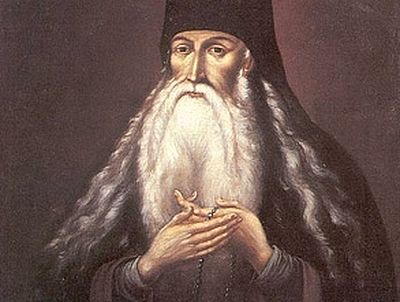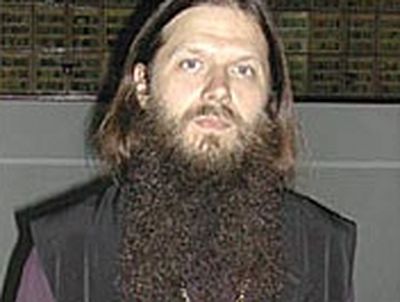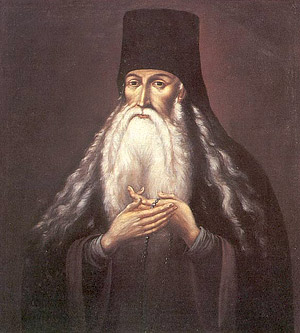 St. Paisius Velichkovsky.
St. Paisius Velichkovsky.
In our early Kievan history, through the efforts of Holy Prince Vladimir and his heirs, Russia began to blossom spiritually, to gain strength, both politically and administratively. Yet with the onslaught of the Tatars and the havoc they wrought, one could say that this blossoming ceased.
Then, despite the heavy losses and sorrows endured by Russia from heathens and the heterodox, the hearts of the Russian people became even more closely bound to the Holy Orthodox Church, and the authority of the Orthodox faith reached a higher level. A new epoch of spiritual loftiness and renewal came in the centuries that followed—the 14th and 15th centuries. This is the era of St Sergius of Radonezh and his ascetic followers who established monasteries throughout northeast Russia, with settlements growing around them. Thus did "Holy Russia" expand and grow.
Once again, in the early 16th century, because Russia found itself separated from the Orthodox East and because Byzantium was under Turkish control, the character of the spiritual struggle in our Fatherland gradually began to shift. Troubles and conflicts arose between the "possessors" and the "non-possessors." Then our monastics were met with a much worse period, that of the reign of Emperor Peter I. It reached the point where monastics were persecuted, especially when foreign figures surrounded our country's empresses. In the second half of the 18th century, a shift began, and Russian monasticism enjoyed a renascence. Of great significance for this rebirth and renewal of Russian monasticism was the Elder Schema-monk Paisius Velichkovsky.
First we will give a brief outline of his biography, and then touch upon his works and his spiritual legacy.
The future Elder Paisius, or as we call him now, St Paisius, was born on December 21, 1722, in the city of Poltava, to a family of priests: his father, grandfather and great-grandfather were all priests. His mother became a nun later in life, as did his grandmother and aunt. He was baptized with the name of Peter. His father, Fr. John, was the rector of Dormition Cathedral. His mother, Irina, worked with children. Peter grew up a quiet and meek boy; he loved to read, and at an early age read every spiritual book in his home and at the cathedral library. Among them were: Holy Scripture, several works of St John Chrysostom and of St Efrem the Syrian.
His biographer noted that he was "bashful and unassuming," so that even his parents almost never heard his voice, and visitors would often ask: "Is he dumb?"
At the age of 13, Peter entered Kiev Theological School, which later became the Theological Academy, where Archbishop Simon (Todorsky) of Pskov taught at the time, along with Metropolitan Arsenii (Matseevich) of Rostov and others. Hieromonk Ioasaf was still there, the future Bishop of Belgorod. The education there was on a very high level. There were some 1200 students at the Academy then. But Peter was not drawn there for this reason, for his heart was consumed by churches, holy monasteries, the caves of those who took vows of silence, and by the conversations he had with friends about the hermit's life. They often met in secluded spots and spoke about spiritually-beneficial things. "It is better," they would say to each other, "to remain in the world than to reject worldly goods just for show, and live a carefree, easy life in a monastery." They swore to each other not to be tonsured in a wealthy monastery where it is impossible to emulate the poverty of Christ.
During his third year of studies, Peter's enthusiasm for his work waned, and his striving for monasticism grew stronger and stronger. School vacation came, and Peter went home. His mother, who had learned of his desire to leave school and join a monastery, categorically objected. Peter had a friend in Poltava by the name of Dimitrii, with whom he went to school, and they took an oath to leave the country together. But their plan failed, because Peter fell ill and had to delay his trip to Kiev. When he regained his health, his mother accompanied him, thinking that he was going to continue to study. But in Kiev, Peter began to rethink his future. He decided to head to Chernigov, to see Elder Pachomii and ask for his counsel and instructions, and for his blessing for his future path. After spending a few days with Fr Pachomii, the latter said to Peter: "It is best for you to go to a monastery not far from Lubech, the homeland of St Anthony of the Caves. There you will find a Hieromonk Ioakim, who will instruct you what to do." Peter did as he was told. When he approached the monastery, he noticed that there were turnpikes and guards between the town of Lubech and the monastery. Peter had no documents with him, and he was afraid that he would be detained. At the same time, a monk appeared on the other side. Stopping near the guard, the monk glanced at the approaching Peter, and remarked to the guard when he called to the boy, "Why do you ask who he is? Don't you see that he is a novice returning to the monastery?" And the guard let Peter pass. And so, with God's help, he was able to settle in the monastery. He was given the duties of the ekomonos (monastery manager), read the Lives of the Saints during meals in the refectory and took on various chores. He lived near Elder Ioakim, who blessed him to wear a cassock, and he rejoiced in his peaceful life.
But Peter was not to remain in this monastery for long. Three months after his arrival, a new superior was appointed for the monastery, and because of certain troubles that followed, Peter left the monastery. He wandered throughout the right bank of Little Russia, which was under assault by Poles and Uniates. Hearing of a hermit who lived on a river island, Peter hastened to see him. His name was Isikhii. He worked on transcribing the works of the Holy Fathers. Peter asked to be taken in as a student. Peter's face swelled up from tears and pleading, but the elder was unmoved: "Child, I am a sinful man and unworthy, and cannot even direct my own poor soul towards God," he said to Peter.
Leaving the hermit, Peter soon found a monastery, called Medvedovsky, which he joined. He had no skills, and the brethren often scoffed at him. He was given the chore of grinding wheat, but he cut his fingers. Then he was given the task of carrying water and clay, cut bread in the refectory, serve food to the monks, and clear and wash dishes. He was also assigned to the kliros. It was in this monastery that he was tonsured to the rassa with the name Platon. His spiritual father went somewhere a few weeks later, and Platon was left without a pastor: "as a lost sheep." He said of himself: "My soul in my youth was very conducive to obedience, but I received no divine gift [of opportunity] because of my unworthiness."
After some time, this monastery was assaulted by Uniates and closed down. Fr Platon went to the Kiev Lavra and worked in the print shop there. Burning with the desire for ascetic labor and the life of a hermit, Fr Platon headed for Moldovlachia, where spiritual life was blossoming, since the monasteries there were under the influence of the Holy Mountain of Athos. He was at the monastery of St Nicholas of Treistch, then went to Cyrkul Monastery. He spent some three years in the monasteries of Moldovlachia under the direction of the elders Fr Vasilius, Fr Mikhail and Fr Onouphrius.
Later, Fr Platon undertook a voyage to Holy Mount Athos, hoping to find spiritual guides and assume ascetic labors. At the time, Fr Platon was 24 years old. The elder's biographer wrote on his move to Mt Athos: "Who can divine the ways of the Lord? And who knows His counsels? By His Divine Providence, He took him from his homeland, took him through many nations, so that he would gather for himself through spiritual purchase great treasures for his soul, and finally brought him to the Holy Mountain of Athos, so that he would continue to amass his spiritual wealth and then give it to all those who seek guidance from him. The Lord made him an emulator of St Anthony of the Caves, also a native of Little Russia. And like St Anthony, who wandered and finally settled on Mt Athos, where he assumed the angelic monastic rank, and, after laying down many years of labor there and earning great spiritual gifts, then returning to his fatherland to sow and multiply monastic life; so did St Paisius, gaining heavenly treasures, returned to his home, to Moldavia, to renew the monastic ranks, to reestablish the fallen common monastic life and plant within it thrice-blessed obedience, illuminating through his teaching the darkness of the ignorant, to grant wisdom through the correction and new translations from the Greek into his native tongue of the Holy Fathers and theological texts."
Hieromonk Tryphon went to the Holy Mountain with Fr Platon. They arrived on Mt Athos on July 4, on the eve of the feast day of St Athanasius of Athos, who lived as a hermit on the Holy Mountain, and then established the first coenobitic monastery.
Today his monastery on the Holy Mountain is the main one, the first one among twenty other monasteries. Resting for a few days at the lavra of St Athanasius, the travelers headed for the Monastery of the Pantocrator, nearby which Slavic monks lived. The road to Pantocrator Monastery was long and difficult. The travelers, weary, sat down to rest, and drank some cold water. From this they caught colds. Hieromonk Tryphon grew delirious, and died soon after arriving at Pantocrator Monastery.
Platon remained to live at Pantocrator Monastery. Gradually he came to know the neighboring monasteries, visiting the local monks and hermit, seeking a spiritual father. It was difficult for him, since he lived in poverty for some four years. In 1750, the spiritual father of Fr Platon from Moldavia, Schema-monk Vasilius, came to Mt Athos, who tonsured Platon to the mantle with the name Paisius. Soon Paisius was joined by his first students, Vissarion and Cesarius; eventually their number grew to 12. In 1758, at the age of 36, Fr Paisius was ordained a hieromonk. With the growth of the number of monks, at their request, Fr Hiero-schemamonk Paisius asked that Pantocrator Monastery give him the cell of Prophet Elias, and began to establish the Skete of Prophet Elias. So Elder Paisius was one of the founder of today's Skete of Prophet Elias on the Holy Mountain of Athos. His skete grew in number. Very soon not only his brotherhood but monks from throughout the Holy Mountain's monasteries became the spiritual children of Fr Paisius. Even Patriarch Seraphim, who lived in retirement in Pantocrator Monastery, came to him for spiritual discussions. All the brethren did handicrafts, and the elder himself made spoons, spending his nights reading and rewriting the books of the Holy Fathers, sleeping no more than three hours a day.
But the enemy of mankind envied the growth of Paisius' brotherhood, their peaceful life and spiritual success. Problems arose among the skete's residents, who were summoned by Elder Athanasius, who lived nearby. This enmity and the ensuing problems disturbed Fr Paisius and his students.
The brotherhood expanded to 50 people, and there was no more room to live, so new cells had to be built, but there were no funds. By the recommendation of several residents of Mt Athos, Fr Paisius, together with his monks, move to the Monastery of St Simon Peter, which was empty at the time. They hoped this way to avoid their conflict with Elder Athanasius. The monastic brethren of St Simon Peter had left because they owed money to the Turkish authorities and could not pay it. But in three months, it became necessary for Fr Paisius and his monks to leave this monastery, too, since the Turks were demanding the repayment of the old debt, and they had no funds. Once again they returned to the Skete of Prophet Elias. But their poverty did not permit them to stay for long, and they had to find a new home.
Elder Paisius decided to move with his brethren to Moldovlachia. In 1763, after 17 years on the Holy Mountain, he and 64 monks left and resettled in Moldavia.
Preparing for his departure, Elder Paisius hired two ships; one he occupied with his Slavic monks, the other took Fr Vissarion and the Moldavian brethren. They first went to the Monastery of the Holy Spirit in Dragomir, Bukovina. The monastery was given to them with forests and all taxes were suspended. Although it was in a state of disrepair, soon, through the monks' efforts, the monastery was brought into good condition. The monastic rule for services was that of Mt Athos. They served in two languages, on the right kliros they sang in Slavonic, on the left, in Moldavian.
In the cell-life of the brethren, the Elder demanded of each monk that he follow his calling with full awareness and earnestness, to be a monk not only by their clothing but in their spirit.
The Elder would spend entire days with the brethren, the doors to his cell would sometimes stay open until 9 o'clock in the evening. Monks would come and go to talk about spiritual and practical matters. Also, the daily reading by the Elder of the books of the Holy Fathers and his discussions on them had great significance for the spiritual life of the monks. But the peaceful life in Dragomir was soon violated by war between Russia and Turkey. Dragomir fell under Austrian control, and so they had to evacuate to Sekul. Here the monks began to help refugees. Problems arose among the monks. Gradually, life in Sekul settled down. The Elder's studies did not cease here, either. His translating work began to develop here. Sekul, of course, proved too small and cramped for his brethren. So through the intercession of Prince Konstantin, Elder Paisius and his monks, with the blessing of Metropolitan Gabriel, was offered the opportunity of moving to Niametz in 1779. But Elder Paisius was not happy with this proposal, for it introduced many complications, and he was already advancing in years.
After some hesitation, the Elder consented to move, but he left some of the monks in Sekula, while he himself moved to Niametz with others. This was the final period of his life, the most difficult one, but also the most fruitful. The number of brethren gathering around him now was over 700. Word of the monastery's lofty spiritual life and that of its Elder spread throughout the Orthodox East. With the help of the Prince, the Elder set up a hospital at the monastery, along with a house of mercy and significantly increased the number of monastic cells. The Elder established the intensive practice of transcribing and translating the works of the Holy Fathers. He gathered a large number of assistants and prepared them especially for his publishing work. He taught them Greek, and for completing their education, sent them to Bucharest Academy.
Thanks to the hard work of this group of trained monks, a great number of correct translations of the Holy Fathers appeared, along with a great many transcriptions of them. According to Prof. A.I. Yatsimirsky, of the thousands of manuscripts kept in the monastery library at Niametz, written in different periods in different languages, including Moldavian, Greek, Latin, Italian, German, Hebrew, Arabic, Turkish, Syrian, Bulgarian, Polish, French and Slavonic, two hundred seventy-six of them are from the period of Elder Paisius, and over 40 of them were written by his hand.
Elder Paisius' growing fame as a teacher of spiritual life inspired many to correspond with him. The Elder responded to these letters, sometimes voluminously. In them, the Elder touches upon various questions of monastic and general church life, giving instructions and offering advice. This correspondence took up a great deal of his time. In these tasks and cares, many years passed unnoticed, and gradually he approached the final days of his life.
His last days were overshadowed by dangerous troubles caused by the war between Russia, Austria and Turkey. Niametz was occupied by the Turks, but the Austrians gathered all their forces and emancipated Niametz, and soon Russian troops approached. The Commander-in-Chief of the Russian Army, Prince Potemkin, came to Jassy along with Archbishop Ambrosius of Slovenia and Poltava. The latter wished to see the renowned Elder Paisius, and arrived in Niametz Monastery, where he was greeted by the monks. This was in 1790. That Sunday, Archbishop Ambrosius officiated at divine liturgy, during which he elevated the Elder to the rank of Archimandrite. The Elder was born in Poltava, and the Archbishop of Poltava performed the elevation.
After the military operations ended, life gradually settled down, and the Elder continued to work as before: he did translations, wrote letters, guided the monks, but his strength was weakening, and he faltered. Not long before his fatal illness, he ceased his translating work. On November 5, 1794, he felt particularly weak and took to his bed. On Sunday, he felt better and came to church to partake of communion. Yet his weakness continued, and on November 15, 1794, at the age of 72, he died peacefully.
News of the repose of Schema-archimandrite Paisius spread rapidly, and a great many monks and faithful gathered in Niametz, Bishop Benjamin came, and the funeral was performed at Ascension Cathedral, followed by his burial.
And so we see that the resettlement of Elder Paisius, through Divine Providence, to Moldovlachia turned out to be very beneficial for his work. Had he remained on Mt Athos, first of all, his brotherhood would not have grown as it did because of a lack of resources and space, and secondly, he could not have had such a great influence on the spiritual life of Orthodox monasticism in Moldavia and Russia.
Within Schema-archimandrite Paisius, personal holiness was combined with love for education, ability to organize monastic coenobitic life, the ability to attract and teach a great host of students, the skill in creating a school of spiritual asceticism and finally, a great literary talent which helped him complete an important, much-needed task—to correct old translations and also make new translations of the ascetic literature of the Holy Fathers.
The literary works of Elder Paisius are varied. Finding among the Slavonic translations of the writings of the Holy Fathers extant at the time a great number of errors, he realized the importance of their painstaking review. For this he began to strenuously search Greek originals on Mt Athos. But these were not easy to come by, since no one ever offered such books for sale. For this reason he had to transcribe them himself, and pay others to do it. He found that by far not all works of the Holy Fathers had been translated into Slavonic. And the second part of this task, the translations themselves, he undertook in Moldavia after he moved there with his monks.
In order to stress the conscientiousness with which this work was performed, we point out that the elder checked and correct the same text three or more times. At the same time, Fr Paisius recognized the insufficiency of even this; he wrote: "To my great sorrow, I see that thisЙis far from perfect and that if the Lord in His mercy extends my life and grants me, almost blind now, the needed sight, I will have to work more on these correctionsЙ"
Only near the end of his life did Elder Paisius broaden the transcription and translation of the books of the Holy Fathers on a wider scale. From here, these works were disseminated throughout the monasteries of the Orthodox East and reached Russia, where they played an exceptional role in the rebirth of Russian monasticism in the 18th and 19th centuries.
As during the beginning of Christianity in Russia, the planting of the seeds of Orthodoxy owed a great deal to Saints Anthony and Theodosius of the Caves and their students, of whom many became the first bishops of Russia, so later did St Sergius and his students work towards the strengthening of Orthodoxy, and finally in the 18th and 19th centuries did the students of St Paisius Velichkovsky play a leading role in the renascence of Russian monasticism and the rise of starchestvo [elderhood].
The students of St Paisius were influential among monastics—on the Holy Mountain, in Moldavia and in Russia. Russia was a source of a particularly large number of his students, under whom a broad rebirth of spiritual life occurred, along with interest in and love for the reading and studying of books; elders and monastic superiors came to the fore who preserved the legacy of St Paisius. One sees three main currents: the Northern, Central and Southern branches. The Northern movement had centers in Solovetsky Monastery, Valaam, St Alexander Nevsky Lavra and St Alexander Svirsky Monastery. The Central movement was concentrated in Moscow, Vladimir guberniya, Optina Hermitage and later in Orlov guberniya. In the South, it was in Ploshchansky Hermitage and Glinsky Hermitage. The circle of influence of Elder Paisius was wide. In Russia, it spread throughout monasteries in 35 dioceses.
Although St Paisius lived abroad and all his activity was outside of Russia, his work still found its way into Russia and brought fruit a hundred-fold within Russian monasticism in the Russian Church.
One sees in the labors of St Paisius something akin to our time. As then, during St Paisius' lifetime, his written work found its way into Russia, where it was rewritten and published—the Slavonic Dobrotolyubiye [Philokalia], the Work of St Isaac of Syria and many other works. Under somewhat different circumstances, the same thing is happening today. Our Russian Church Abroad is carrying out its mission abroad among Russian Orthodox people and at the same time, its fruits are being sent to Russia, in the form of the works of the Holy Fathers and ecclesiastical literature, where there is a terrible dearth of the Word of God and of spiritual literature [this article was written in the early 1990's—ed.].
True, there is a great difference between the time of St Paisius and our time. St Paisius lived in an Orthodox country, and although the same publishing possibilities did not exist there, one could freely transcribe and re-transcribe manuscripts and send them to Russia, and print and disseminate them there. Today, although we live in heterodox surroundings, we can freely print large editions, but disseminating spiritual literature among our brethren in Russia is virtually impossible. But with God's help, some things can be sent there, and this small amount, we hope, will bring forth fruit a hundredfold. May this be, o Lord, by the prayers of St Paisius!
This is the brief biography, struggles, labors and merits of St Paisius Velichkovsky, the restorer of the strict coenobitic monasticism and founder of Russian starchestvo of the 19th century.
This is the good that can be done by one person--of course, with God's help. Maybe among our young people we will find those willing to serve God, serve the Russian Orthodox Church. Young men and women are needed, our monasteries are in need of young forces, and if Russia is born again, she will need experienced, prepared people. Those who hear this call, respond!
This brief item was based on the book of Protopriest Sergii Chetverikov, Starets Paisii Velichkovsky, and several other articles.
The glorification of St Paisius was performed in our Russian Orthodox Church Outside of Russia on the feast day of Holy Prophet Elias on July 20, 1982 at the Russian Skete of St Elias on Mt Athos, which was founded by St Paisius.
